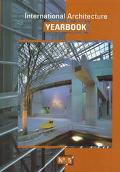

 |

|

The average rating for International Architecture Yearbook, Vol. 5 based on 2 reviews is 4.5 stars.
Review # 1 was written on 2014-12-28 00:00:00 Joseph Ragano Joseph Raganogood |
Review # 2 was written on 2014-06-13 00:00:00 Trisha Phillips Trisha PhillipsFiske Kimball (1888-1955)—the New England-born, Harvard-educated architect, historian, and museum director wrote this ground-breaking study of American colonial homes in the 1920s. It was praised for taking the little-before researched subject of domestic homes for an architectural subject instead of public structures. Naturally the private domestic structures were more difficult to research via traditional means as most architectural archives are kept by public institutions. He breaks American homes up into three sections: 17th-century homes, 18th-century homes, and post-revolution homes through 1830. [1] 17th-century homes more consistently seem to have developed in response to economic conditions effecting standard of living rather than artistic evolution (though English influences and existing community styles explain eclectic variations). [2] 18th-century colonial houses followed as nearly as possible the changing styles of England (much greater variety of forms for classification. Kimball was the FIRST TO FULLY ACKNOWLEDGE the existence of “hand books of designs” that were widely circulated among the builders of the day to inform construction and decoration). [3] the early Republic benefitted from architectural books of designs from continental Europe and wedded the ideal of the classical form (from Greek and Roman precedents, especially temples) and the ideal of modern convenience (from King Louis XV of France). Americans combined these two ideals, but Kimball stresses that classical forms triumphed, in order to push the evolution of the American house into a uniquely new form (145). The classical revival had as its prophet Thomas Jefferson but many (including Washington) adopted this classical “temple” ideal in their American home construction. This book is surprisingly readable and astonishingly early. It has been widely influential on pioneering the preservation movement; architectural preservation got well-underway in large thanks to this book well before Penn Station went down and legislation followed in 1966 to prevent further cultural heritage destruction. |
CAN'T FIND WHAT YOU'RE LOOKING FOR? CLICK HERE!!!